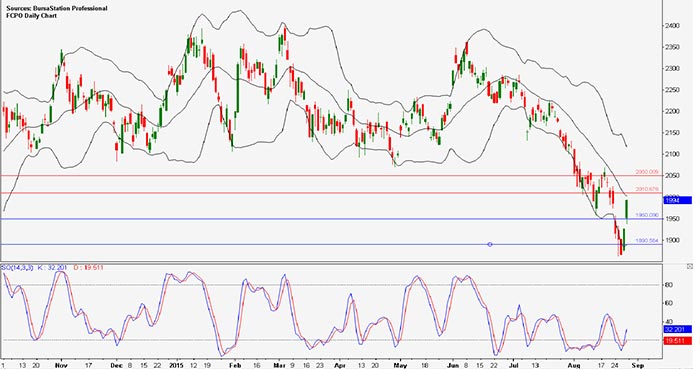 Malaysian palm oil futures climbed higher on Friday to 1,994, due to tracking other commodity markets while the weak ringgit also supported the price.
Malaysian palm oil futures climbed higher on Friday to 1,994, due to tracking other commodity markets while the weak ringgit also supported the price.
Future Crude Palm Oil (FCPO) benchmark November 2015 contract settled at 1,994 on Friday, up eight points or 0.4 per cent from 1,986 last Friday.
Trading volume increased to 255,662 contracts from 196,922 contracts from last Monday to Thursday.
Open interest based increased to 885,307 contracts from 853,949 contracts from last Monday to Thursday.
Cargo surveyor, Intertek Testing Services (ITS), reported that exports of Malaysia’s palm oil products during August 1 to 25 increased 10.75 per cent to 1.276 million tonnes compared with 1.152 million tonnes during July 1 to 25.
Another cargo surveyor, Societe Generale de Surveillance (SGS), reported that Malaysia’s palm oil exports during August 1 to 25 increased 9.1 per cent to 1.285 million tonnes compared with 1.179 million tonnes during July 1 to 25.
Demand rose from the EU, India and the rest of the subcontinent, while demand weakened from the US and China.
Spot ringgit strengthened on Friday to 4.197 but headed for a 10th weekly decline, its longest losing streak since 2013, as thousands of protesters prepared for a weekend march to demand for Prime Minister Datuk Seri Najib Tun Razak’s resignation.
Indonesia’s export tax for crude palm oil in September will be retained at zero per cent, an official at Indonesia’s trade ministry told Reuters by a text message on Wednesday.
Palm oil prices will likely trade between RM1,900 and RM2,000 per tonne between now to September, said the chief executive of Malaysia’s Sime Darby Bhd SIME.KL, the world’s top oil palm planter by land size.
On Monday and Tuesday, the price fell for the fifth successive day, touching the lowest since March 2009, as the tropical oil tracked other global markets lower on concerns about the Chinese economy.
However, fresh data showed stronger exports this month which kept a lid on losses.
On Wednesday, the price fell for the sixth consecutive day, towards a six and a half year low, as weakness in external markets sapped appetite for the edible oil and the weak ringgit offered little support.
On Thursday and Friday, the price rose, ending its sixth successive days of decline, recovering losses made during the previous day while tracking global equity and commodities markets.
The recent selloff had also brought down palm prices to an attractive level for buyers. The weakening ringgit also provided support but was set to post their ninth straight weekly loss after a global market rout earlier this week.
Technical analysis
According to the weekly FCPO chart, the price opened below the bottom Bollinger band, while the SO remained in oversold territory.
A downside gap was formed from 1,945 to 1,985, which might be covered or indicate there the potential to test the psychological barrier at 1,900 in the near term.
By the end of the week, the previous gap was covered, while the price tested the bottom Bollinger band, and the psychological level at 1,900, closing above.
A bullish hammer candlestick was formed, indicating reversal of downtrend after testing the psychological barrier at 1,900.
According to the daily FCPO chart, on Monday, the price opened below the bottom Bollinger band and support level at 1,950, while the SO entered oversold territory.
A downside gap was formed from 1,945 to 1,985, which might be covered in the near term or indicate continuation of downward pressure towards the psychological barrier at 1,900.
By the later session, the previous gap was unable to be covered, while the price tested support level at 1,910, closing above, and closing below the bottom Bollinger band.
Average volume was above the average daily volume.
On Tuesday, the price opened below the bottom Bollinger band and above the support level at 1,910.
By the later session, the price tested the psychological barrier at 1,900, closing above, and closing below the bottom Bollinger band.
On Wednesday, the price opened above the psychological barrier 1,900 and bottom Bollinger band, while the SO remained in oversold territory.
By the later session, the price tested the psychological barrier at 1,900, and bottom Bollinger band, closing below.
A bearish marubuzo candlestick was formed indicating potential for downward pressure might continue.
On Thursday, the price opened above the bottom Bollinger band and below the psychological barrier at 1,900.
By the later session, the price tested the bottom Bollinger and support level at 1,910, closing above, while daily volume was above the average daily volume.
A bullish marubuzo candlestick was formed, showing a strong reversal from previous day.
On Friday, the price opened above the bottom Bollinger band and support level at 1,910, while the SO exits oversold territory.
An upside gap was formed from 1,930 to 1,950, which might be covered in the near term or indicate a reversal of downtrend earlier in the week.
By the later session, the previous gap was unable to be covered, while the price tested the middle Bollinger band, closing below.
In the coming week, the price has potential to range between 1,900 and 2,000.
Resistance lines will be placed at 2,010 and 2,050, while support lines will be positioned at 1,950 and 1,890, these levels will be observed this coming week.
Major fundamental news this coming week
Malaysia Public Holiday Independence/National Day on the August 31 (Monday).
ITS and SGS report released on September 1 (Tuesday).
Oriental Pacific Futures (OPF) is a Trading Participant and Clearing Participant of Bursa Malaysia Derivatives. You may reach us at www.opf.com.my. Disclaimer: This article is written for general information only. The writers, publishers and OPF will not be held liable for any damage or trading losses that result from the use of this article.
